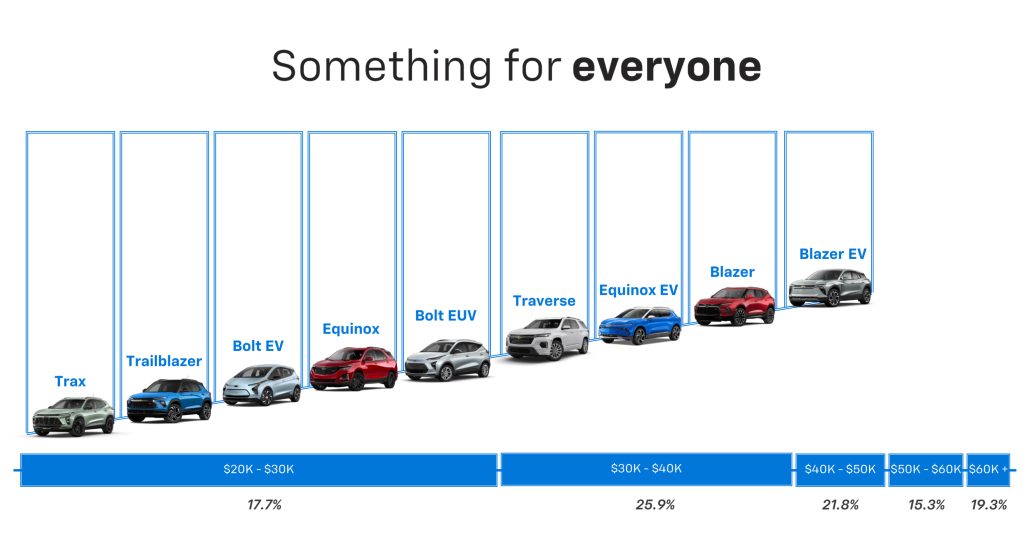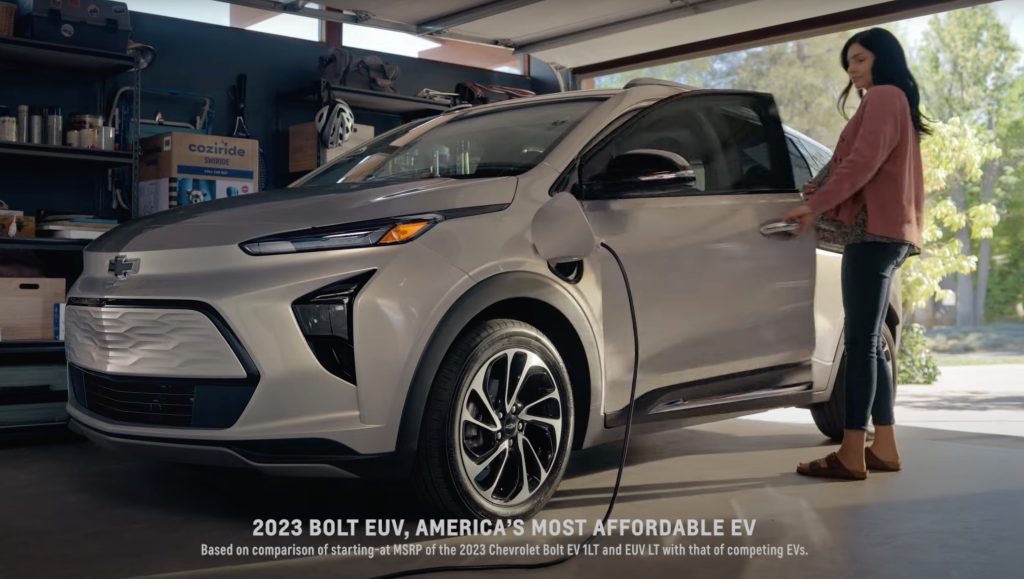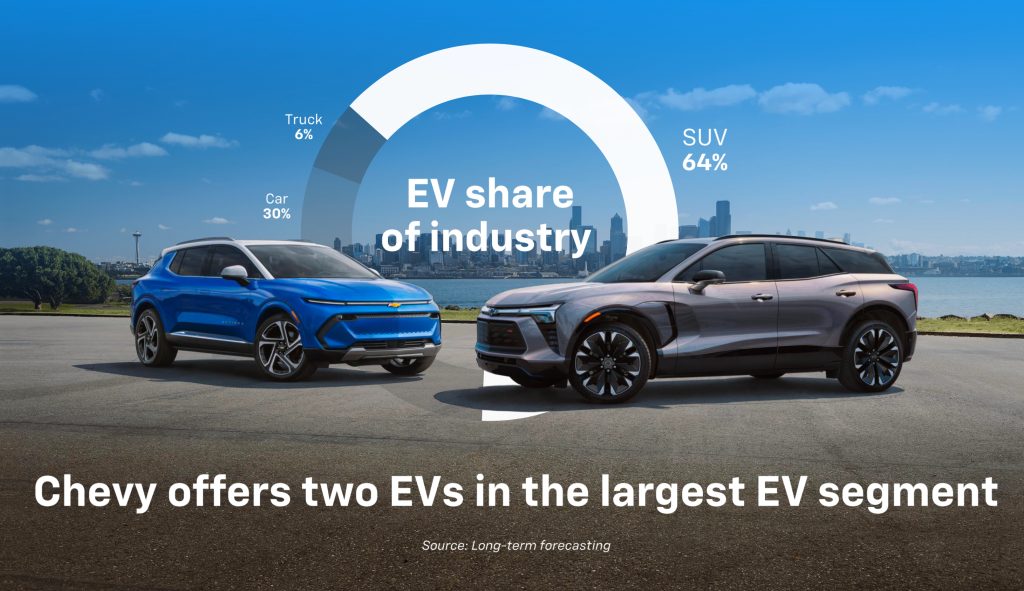
The Bolt EV is not coming back in Ultium format, according to recent statements made by GM. Instead, GM will resurrect the larger Bolt EUV and place it right alongside the Equinox EV in the latest example of the long line of inexplicable moves by GM in the EV space.
The Chevy Bolt is GM’s most popular and best-selling EV, which is currently enjoying its best year of sales ever. The EUV is a newer, larger variant of the Bolt EV, which has been selling better in recent years, but the Bolt EV is still the overall better seller across the history of the nameplate.
The Bolt EV as a hatchback is a unique vehicle in a market full of CUVs and SUVs.
But the Bolt is based on GM’s old battery platform, and GM’s Ultium platform is the new hotness.
So, the Bolt EV is going out of production at the end of this year, to be replaced by an Ultium-based Bolt which we now know is coming in 2025.
But it turns out that we won’t actually be getting a Boltium EV – we’ll only get the larger, more expensive EUV version.
GM CEO Mary Barra gave the first hint last month that the Ultium Bolt would take “the best attributes of the Bolt EUV”
“Our prior portfolio plans included several newly designed vehicles in the entry level segments and a capital commitment of $5 billion over the next several years. However, by leveraging the best attributes of today’s Bolt EUV, as well as Ultium platform, our software, and NACS, we will deliver an even better driving, charging, and ownership experience with a vehicle we know customers love. In the process, we are saving billions in capital and engineering expenses, delivering a significantly cost improved battery pack using purchased LFP cells. We are getting to market at least two years faster. And unit cost will be substantially lower.”
GM CEO Mary Barra
There was some hope that this statement was ambiguous enough and that Barra meant to cover both the EV and EUV with it, but alas, it seems not to be the case.
We think this is a big mistake, especially given all the recent excitement around the Volvo EX30, a vehicle quite close to the Bolt EV’s footprint and layout. Given the interest we’re seeing in that small, well-priced hatchback/SUV, which despite being called an SUV is still among the smaller EVs currently being introduced, one would think that GM might see that a “Hot Hatch meets MicroSUV” format is popular. Surely that’s why they were bringing back the Bolt in the first place?
| Vehicle | Bolt EUV | Volvo EX30 | Bolt EV |
| Length | 169.5 in | 166.7 in | 163.2 in |
| Width | 69.7 in | 72.3 in | 69.5 in |
| Height | 63.6 in | 61.2 in | 63.4 in |
| Wheelbase | 105.3 in | 104.3 in | 102.4 in |
Besides, Chevy already has the Equinox EV coming out soon, which fits into the “small(ish)” SUV segment and while longer and slightly wider than the EUV, has the same amount of cargo space. A Bolt EV-sized hot hatch could compare favorably against the Volvo EX30, and offer more differentiation against the larger Equinox, but now, Chevy will just have three electric SUVs and nothing for customers who want something smaller, or who want a sedan, or who want… anything but an SUV.
So it seems like the SUV virus has infected everyone – including the best deal in all of EVs.
Something for everyone? How about… any car?
This week, we drove the Blazer EV, which you’ll hear our impressions of on Wednesday. During that event, Chevy told us that it has “something for everyone,” accompanied by this slide:

Well, I like driving small cars. What, in that graphic, is for me? Am I not part of “everyone?” Feel free to tell us in the comments below if you, too, are not part of everyone.
But this is a reflection of SUVs being the largest segment in the US vehicle market right now. Vehicles in the US have been getting bigger and bigger, leading to higher pedestrian deaths and much worse emissions.
SUVs are everywhere – is it consumer demand, or something else?
There are a number of reasons for this, though most observers go no further than to pretend that it is solely due to consumer demand. But that’s not the whole story – Americans are being pushed towards SUVs in many ways.
Right out of the gate, just look at the graphic above. America’s largest manufacturer simply doesn’t offer anything but SUVs. If that’s the case, it’s tough for anyone who doesn’t want an SUV to find a car to buy, doesn’t it?
The only vehicle on that list which might not qualify as an SUV is the Bolt EV hatchback. It’s still tall, but at least it’s pretty compact at 163″ in length (by comparison, the upcoming Equinox EV is 190″ long – and yet has an identical 57 cubic feet of cargo space as the Bolt, both with seats down).
So, maybe GM does have a vehicle for those of us who don’t want SUVs? Well, maybe… unless you ask GM, whose advertisements fail to mention that the car even exists.
This recent Bolt EUV ad refers to the Bolt EUV as the “most affordable EV in America,” which is factually untrue. In fact, the Bolt EV is the most affordable EV in America, not the EUV, as the EV is $1,300 cheaper than the EUV.

And of course GM, and its dealers, would rather sell you a more expensive car than a more reasonable and responsible one. SUVs tend to be more expensive, and automakers have attached value to the term, and thus will happily push customers into far more car than they need or want in order to get a few more dollars out of them.
Beyond that, regulations also push manufacturers into producing more SUVs. Fuel economy regulations have long included a “footprint rule” that allows larger vehicles to get away with lower fuel efficiency, ironically encouraging manufacturers to build larger, less efficient vehicles to help meet fleet economy regulations.
Top comment by Cypress
Nonsensical hand wringing.
The EX30 is 3in longer and 2in wider than the Bolt EV,
And the EX30 is 3in shorter in length but still 2in wider than the Bolt EUV.
Neither the EUV or EX30 are really SUVs, and both closer to hatchbacks.
Even new, EV-specific regulations have this problem. The Inflation Reduction Act includes tax credits for EVs – but these are capped at $55,000 MSRP for cars and $80,000 for SUVs and trucks, which means manufacturers can make more revenue by channeling people into EV SUVs.
But in a possible saving grace for regulations, the most recent EPA regulations do include an extremely exciting line: “EPA is proposing … to narrow the numerical stringency difference between the car and truck curves.” This suggests that the EPA understands it messed up and is trying to correct the error that has led to the pedestrian-killing SUV takeover of the market, but it will take years until we see the effects of this positive move.
SUVs may be the more dominant segment due to the various reasons listed above, but even despite all of these entities pushing consumers towards land yachts, cars still carry on. GM shared a slide (with an inaccurate pie chart, no less) showing that 30% of EVs are still cars, not SUVs:

And yet, with this move, GM is ignoring 30% of its customers by eliminating the one car-like EV it sells. “Something for everyone,” right?
FTC: We use income earning auto affiliate links. More.





Comments